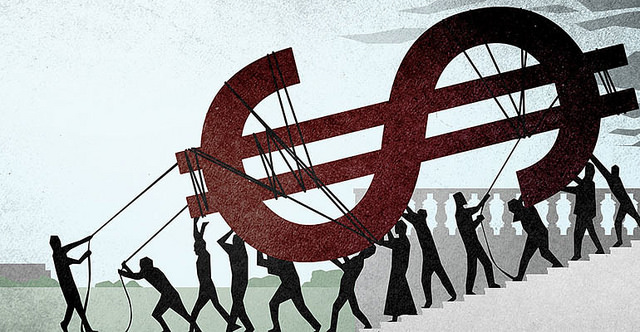Investors are on edge. We’re barely into the New Year and markets have been left shaken by the Swiss franc’s biggest ever one-day move; an election win for a populist party that’s demanding to renegotiate Greece’s relationship with the European Union; more evidence of a slowdown in China; and worries that cheap oil reflects weak global demand rather than a turf war between producers. Against this uncertain backdrop investors are looking again to central bankers for coordinated action, yet policymakers look set to move in opposite directions.
Stock pickers hoping this year will herald a painless transition back to a world in which central bankers and liquidity play reduced roles in determining investment returns will most likely be disappointed. All this uncertainty is making it harder for the US Federal Reserve to decide when best to raise interest rates in the first step of so-called monetary policy ‘normalisation’, even as Europe and Japan remain committed to further stimulus.
More recently emerging markets have suffered. Within six months what had been a narrative of slow recovery has turned once again into an exercise in spotting the weakest link. Like predators isolating the weakest member of the herd, short-sellers are already said to be rounding on the currencies, bonds and equities of selected emerging markets.
Many of the arguments that sustain the critics have been around for a while: a rising dollar makes assets in ‘riskier’ parts of the world less attractive to international investors; countries that rely on foreign capital to plug gaps in current account deficits will come under pressure; higher US interest rates force emerging economies to follow suit despite sluggish growth.
All of which is true, to a degree. But emerging economies are still growing faster than most developed ones and will do so for many years to come; emerging economies are in better shape today because they began reducing current account deficits after the ‘taper tantrum’ of 2013, when the suggestion of an end to Fed stimulus policies caused a panic; and emerging markets hiked interest rates following the taper tantrum and so, with the collapse of oil prices driving deflationary pressures, actually have room to cut. At the country level, most emerging countries are well- positioned to handle the latest tempest.
Yet, now there’s a new concern – the level of corporate debt denominated in foreign currencies. The argument goes like this: ever since the global financial crisis, emerging market companies have gorged on cheap debt, especially dollar debt. So with the dollar (and now the Swiss franc) surging higher, corporate borrowers face ever more expensive debt repayments, even as revenues slow and show no sign of imminent recovery.
The numbers certainly look scary. From 2009 until last year, dollar- denominated borrowing by the private sector in the emerging markets increased more than 100 per cent, or by more than $1 trillion. With memories of the global financial crisis still fresh for many people, it is only right that the risks of excessive debt shouldn’t be lightly dismissed.
However, these numbers need to be reappraised within the proper context. While some economies may still be ‘emerging’ in terms of governance and market liberalisation, they now rank in size with the biggest. The obvious example is China which, by one measure, overtook the United States last year as the world’s largest economy.
All emerging markets grew rapidly over the past two decades and once the size of these economies is taken into consideration, a very different picture emerges. In fact, external emerging market debt as a percentage of gross domestic product (GDP) has been remarkably stable – around 40 per cent – since 1995. Meanwhile, external emerging market debt (as a percentage of GDP) that’s attributable to the private sector has been almost flat over the same period and remains well under 10 per cent.
That’s not to say it isn’t an issue. Debt levels – the total level of all borrowing – need to be carefully monitored. Let’s not forget that the lion’s share of debt in emerging markets is still denominated in local currencies and there has been an expansion of all debt. But we don’t think that existing levels of foreign debt specifically represent a systemic risk.
Another reason for our view is because a lot of this foreign currency debt is linked to borrowing by commodities companies, especially those in the oil and gas sector. Sharp falls in commodity prices are a problem, but it is also an industry in which dollar borrowing is matched by dollar revenues, so the danger of a currency mismatch of the type we saw in the 1997/98 Asian crisis is greatly reduced.
Of course, high-yield Chinese property bonds are now in the spotlight with Shenzhen-based Kaisa Group Holdings having missed a coupon payment and its creditors scrambling to protect their interests. Chinese companies have become some of the biggest issuers of foreign currency bonds as they sought to sidestep credit curbs at home. But investors still recognise that, on this occasion, the problems are company-specific and panic hasn’t spread to the larger developers. We’re still confident in the ability of the authorities to manage debt levels.
The coming year will be challenging for many markets, not just those in the developing world. However, we feel that most emerging markets are set to benefit from oil prices at current levels (although oil exporters are obviously big losers) and companies will continue to make steady progress trimming fat to operate more efficiently. Sure, investor sentiment remains poor and this won’t help with capital outflows, but with price-to-book valuations well below the five and 10-year averages we think there is plenty of value.
Column by Devan Kaloo, Head of Global Emerging Markets, responsible for the London based Global Emerging Markets Equity Team at Aberdeen AM





 By Alicia Miguel Serrano
By Alicia Miguel Serrano